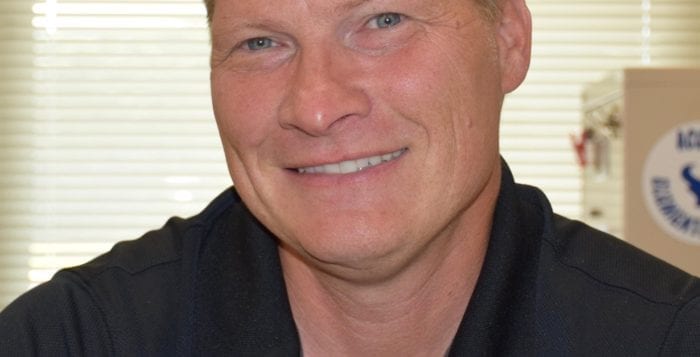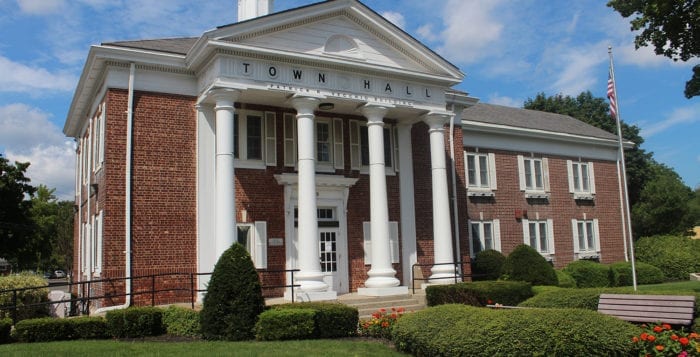By Kevin Redding
‘Lucky is the child who listens to a story from an elder and treasures it for years.’
— Barbara Russell,
Town of Brookhaven historian
Margo Arceri first heard about George Washington’s Setauket spies from her Strong’s Neck neighbor and local historian, Kate W. Strong, in the early 1970s. Arceri lights up when talking about her favorite spy, Anna Smith Strong.
“Kate W. Strong, Anna Smith Strong’s great-great-granddaughter, originally told me about the Culper Spy Ring when I used to visit her with my neighbor and Strong descendant Raymond Brewster Strong III. One of her stories was about Nancy (Anna Smith Strong’s nickname) and her magic clothesline. My love of history grew from there,” she said.
Six years ago Arceri approached the Three Village Historical Society’s President Steve Hintze and the board about conducting walking, biking and kayaking tours while sharing her knowledge of George Washington’s Long Island intelligence during the American Revolution.
Today, Arceri runs Tri-Spy Tours in the Three Village area, which follows in the actual footsteps of the Culper Spy Ring. “I wanted to target that 20- to 60-year-old active person,” she said. “I have to thank AMC’s miniseries ‘Turn’ because 80 percent of the people who sign up for the tour do so because of that show,” she laughs.
It was during one of those tours that Arceri came up with the idea of having a Culper Spy Day, a day to honor the members of Long Island’s brave Patriot spy ring who helped change the course of history and helped Washington win the Revolutionary War.
“Visiting places like the Brewster House, which is owned by The Ward Melville Heritage Organization, the grave site of genre artist William Sidney Mount at the Setauket Presbyterian Church cemetery (whose paintings are at The Long Island Museum) and the Country House, which was built in the 1700s,” Arceri thought “there has to be a day designated to celebrating all these organizations in the Three Villages and surrounding areas; where each of us can give our little piece of the story and that’s how Culper Spy Day developed.”
After a successful four-year run, the fifth annual Culper Spy Day will be held on Saturday, Sept. 14 from 9 a.m. to 4 p.m. offering self-guided tours of over 20 locations including the addition of the 42nd Royal Highland Regiment of Foot encampment with musket firing and battle drills on the Village Green for the ultimate Culper Spy Day experience. “The more the merrier,” laughs Arceri.
One of the highlights every year during the daylong dive into history is the opportunity to visit two neighboring and active churches in Setauket — the Caroline Church of Brookhaven and the Setauket Presbyterian Church, both on the National Register of Historic Places and prominent stomping grounds for soldiers and spies during the Revolutionary War. There will be docent-led tours through the historic structures and their premises, and visitors will be free to roam each church’s expansive cemetery, where some of the weathered gravestones stacked alongside each other belong to those who helped win our independence.
While the congregations have a good relationship these days, and together co-own and maintain the Setauket Village Green that separates the two sites, there was a time when the churches couldn’t have been more opposed. In fact, the conflict of the American Revolution was represented quite well, on a local front, by the two Setauket buildings.
Caroline Church of Brookhaven

The Caroline Church’s congregation began in 1723 and was officially erected as a building six years later in 1729. Aside from some modern renovations, including the installation of colored glass windows around the interior of the church in the late 19th century, in terms of what it looked like during the war, “What you’re looking at was here,” Town of Brookhaven historian Barbara Russell tells church tourists when they inevitably ask upon enter the historic building.
“The original wood beams are still here,” said Russell, pointing out the hull-shaped ceiling of the beautiful and age-scented church. “I think it’s important to say that we’re still a church. Believe it or not, there are people who walk in here on Culper Spy Day thinking we’re just some kind of museum and we’re not. We value our historic building, but we’re still an active Episcopal congregation.”
“This is a special place,” Russell continued. “We’re coming up on the congregation’s 300th anniversary. Our country isn’t even that old yet!” According to the town historian, the Episcopalian church was an Anglican one before the Revolution, and was the house of worship for Loyalists in the area, those American colonists who remained supportive of the British crown during the fighting.
In fact, the original congregation’s staunch loyalty to Britain gave the building its current name. It was originally Christ Church, but, according to Russell, it is alleged that someone wrote to Queen Wilhelmina Karoline of Brandenburgh-Anspach, queen of George II throughout the early 18th century, informing her of the church when it was brand new, compelling her highness to send its members a silver communion service.
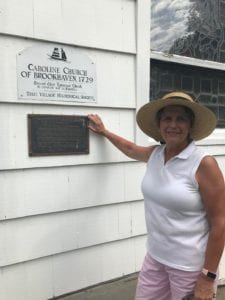
Although Russell said the royal gift is nowhere to be found within the church, there are Vestry minutes that record the unanimous decision “…that this Church and parish Shall in honour of our gracious Queen, her most Serene Britannic Majesty be hereafter called Caroline parish and Caroline Church, and this be entered upon record in Our Vestry books ad futuram rei Memoriam.”
A portrait of the queen hangs on the wall of the church’s lobby, on the left side when you enter. Also in that first room, encased in plexiglass, is a musket ball that was found embedded in a wall near the building’s southwest corner when the church was being restored by philanthropist Ward Melville in 1937. Assumed to be a remnant of the Raid of Setauket in 1777, the single, approximately 69-caliber projectile was, according to historians at the site, most likely fired from an American soldier’s French musket during the raid.
“It was either somebody firing at the church steeple or a soldier that didn’t have very good aim,” Russell laughed.
Among the gravestones in the church’s cemetery is one for Mary Longbotham Muirson, wife of Dr. George Muirson, a Setauket resident, physician, Loyalist and worshipper at the church. Although he was a medical doctor, Dr. Muirson was not welcome to stay in the town after the war due to his Loyalist beliefs; his lands were confiscated and he was banished. It’s not clear what happened to Mary Muirson, but there’s a letter that was sent to her from her husband in April 1784, so it’s most likely that she remained in Setauket.
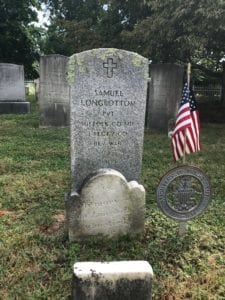
Most interestingly, Muirson’s son, Heathcote Muirson, from a previous marriage, fought on the Patriot side; he took part in the raid on Fort St. George in Mastic in 1780 under the command of Col. Benjamin Tallmadge — of course, East Setauket’s most famous hero and leader of the Culper Spy Ring — and ultimately died from wounds suffered at Lloyd Neck. Muirson’s other son was a Loyalist.
“So there was a father and son on either side of the conflict. We saw that happen again and again, right?” Russell observed, overlooking the gravestones that include Revolutionary War veterans and Suffolk County Militia soldiers.
Russell said there are a total of six Patriot graves in the Caroline churchyard including Israel Bennett, Robert Jayne, Samuel Jayne, Benjamin Jones, Vincent Jones and Samuel Longbottom, all of which can be visited on Culper Spy Day. Participants are encouraged to walk through and explore the area on their own. However, docents will be in the church and in the church’s History Center on the lower level of the Parish House for tours and to answer questions.
Setauket Presbyterian Church

High among the list of helpful experts on the premises is Art Billadello, a longtime member and past president of the Three Village Historical Society and the Setauket Presbyterian Church’s go-to representative. He’s been a member of the congregation since 1986 and, for more than 30 years, Billadello has taken great pride in preserving and sharing the history of the Federal-style church — as well as debunking any and all myths that surround it, of which there have been plenty.
Many of these falsities can be linked to “TURN,” which has been a blessing and a curse for the site, according to Billadello.
“When that [mini-series] was running, if I had 30 people on a Revolutionary History Walking Tour, the first thing I’d ask as soon as they got out of their cars was, ‘How many of you watched ‘TURN’?’,” Billadello recalls. “Out of those 30 people, 20 hands would go up. Then the second thing I’ll say to them is, ‘Well, I’m gonna turn you around 180 degrees to the truth …’ because they would believe everything on the show, which isn’t all accurate … that’s Hollywood.”
Despite letting down some faithful viewers of the AMC program by dispelling the “sexier” and more fabricated aspects of the show in favor of what really happened, Billadello agrees with Arceri that “TURN” has been beneficial by bringing hordes of visitors from all over to the church.

The truth is, the Presbyterian Church that stands at 5 Caroline Avenue today is not the one that was there during the American Revolution. “The new church,” as Billadello calls it, is at least the third structure on the site. The Revolutionary-Era Church, built circa 1714, looked more like the Caroline Church. It was destroyed and fortified in 1777 by the Loyalists who worshipped across the street and looked down on the Presbyterian, a congregation that was occupied by supporters of America’s independence.
In fact, Benjamin Tallmadge’s father was a pastor at the church from 1754 — the year of Tallmadge’s birth — until he died in 1786. His father and mother are among those buried in the church’s graveyard, along with Abraham Woodhull, another leading member of the Culper Spy Ring, whose commemorative monument is one of the most impressive on the property.
Arceri’s hero, Anna Smith Strong, is buried in the neighboring St. Georges Manor Cemetery in Strong’s Neck. According to Billadello, she once used her Loyalist connections to get her husband, Selah Strong, released from the prison ship where he was confined. The two lived in Setauket for the duration of their lives following the war.
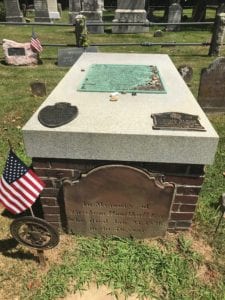 “This history is so important because it was ordinary civilians, from this town, doing extraordinary things,” Billadello said. “All school kids know about George Washington, but these regular people who helped win our independence are virtually unknown.”
“This history is so important because it was ordinary civilians, from this town, doing extraordinary things,” Billadello said. “All school kids know about George Washington, but these regular people who helped win our independence are virtually unknown.”
Indeed, Woodhull was a farmer and Caleb Brewster was a blacksmith while Austin Roe was a tavernkeeper. “They could’ve been caught and hung,” explained Billadello.
The Presbyterian Church was built back up around 1781, but in 1811, it was struck by lightning and most of it burned down as a result. The structurally sound beams, which were exposed to the fire and appear charred, were re-used in the steeple of the church and remain on the property.
By the end of 1811, the church was rebuilt for a third time and was officially dedicated in the spring of the following year. While, as in the case of the Caroline Church, there have been some modern renovations of its interior, like carpeting, rail and pew replacements, the Presbyterian Church is irrefutably historic inside. There’s even a pew door from 1811 on display.
During Culper Spy Day, docents will be on hand to give tours of the historic church and cemetery.
Arceri’s favorite part of the day is “seeing all these different organizations coming together as a whole. It really is our Revolutionary story,” she said. “Everywhere you turn in the Three Villages you are looking at an artifact, and as the historical society believes, the community is our museum and I would really love to put that on the forefront of people’s minds.”
Tickets are $25 adults, $5 children ages 6 to 12 and may be purchased in advance at the Three Village Historical Society (TVHS), 93 North Country Road, Setauket, by calling 631-751-3730 or by visiting www.tvhs.org. Veterans and children under the age of 6 are free.
Tickets may be picked up at the TVHS from Sept. 10 to 14. At that time, participants will receive a bracelet and a copy of the Culper Spy Day map with all event listings and include access to 21 Culper Spy Ring locations. If available, tickets may be purchased at the historical society on the day of the event.
Participating organizations:
The fifth annual Culper Spy Day is presented by Tri-Spy Tours, the Three Village Historical Society, The Long Island Museum and The Ward Melville Heritage Organization in collaboration with The Benjamin Tallmadge District of the Boy Scouts, Brewster House, Campus Bicycle, Caroline Church of Brookhaven, Country House Restaurant, Custom House, Daughters of the American Revolution Anna Smith Strong Chapter, Discover Long Island, 1750 David Conklin Farmhouse Museum, 1795 Dr. Daniel Kissam House Museum, Drowned Meadow Cottage Museum, Incorporated Village of Port Jefferson, East Hampton Library, Long Island Collection, Emma S. Clark Memorial Library, Fairfield Historical Society, Fairfield Museum & History Center, Frank Melville Memorial Park, Fraunces Tavern Museum, Gallery North, History Close at Hand, Huntington Historical Society, Joseph Lloyd Manor House, Ketcham Inn Foundation, Litchfield Historical Society, Old Methodist Church, Paumanok Tours, Preservation Long Island, Raynham Hall Museum, Rock Hall Museum, 42nd Royal Highland Regiment of Foot, Setauket Elementary School, Setauket Harbor Task Force, Setauket Neighborhood House, Setauket Presbyterian Church, Sherwood-Jayne Farm, Special Collections Stony Brook University Libraries, Stirring up History, Stony Brook Grist Mill, Three Village Community Trust, The Three Village Inn, The Thompson House, Times Beacon Record News Media and the Underhill Society of America.





 The Kings Park facility even had what they called York Hall, where patients would watch movies, play basketball, perform shows and attend functions. The facility also had its own water tower, railroad station, space for masonry work, independent fire and police force and the Veterans Memorial Hospital, which was a group of 17 buildings used to treat veterans that came home from World War I with mental conditions.
The Kings Park facility even had what they called York Hall, where patients would watch movies, play basketball, perform shows and attend functions. The facility also had its own water tower, railroad station, space for masonry work, independent fire and police force and the Veterans Memorial Hospital, which was a group of 17 buildings used to treat veterans that came home from World War I with mental conditions.




